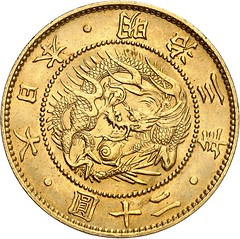
PREV ARTICLE
NEXT ARTICLE
FULL ISSUE
PREV FULL ISSUE
KüNKER OFFERS 1870 JAPAN 20 YENKünker is also offering a very rare and important Japanese coin in its upcoming sale. -Editor A New Currency for a New Japan On 27 September 2021, an icon of Japanese coinage will be auctioned off as part of the Schwarz Collection offered by Künker: the 20 yen piece of 1870 of which only very few specimens were minted to be given to dignitaries of the imperial court. We tell its story. The fast industrialization of Japan, which started in the years after 1868, did already amaze and impress those who witnessed it at the time. While other Far Eastern countries of the 19th century became more and more dependent on western countries, Japan managed to stay independent while making use of European technology and know-how. The foundations for this development were laid during the Boshin civil war.
Above all, educated young people blamed the policies of the Tokugawa shogunate for the economic misery. When Emperor Komei died on 30 January 1867, they hoped for a new beginning under the rule of the just 14-year-old Emperor Mutsuhito, who chose the meaningful throne name Meiji (= enlightened rule). What remains remarkable about the Boshin War is the fact that both the victors and the defeated deliberately rejected foreign aid, which, by the way, would have certainly been offered. France, in particular, could only be kept from intervening in the war with much effort and diplomacy.
The reason why the political powers of Japan did not want aid from other countries were
expressed by the commander of Edo on the occasion of the surrender on 6 April 1868:
Japan as a Client The corps formed by young civil servants (the average age of them was just over 30 years) were ready to break new ground. The Iwakura Mission – during which high-ranking politicians negotiated the repeal of unequal treaties and, at the same time, studied and evaluated western institutions – became legendary. When this mission started at the end of 1871, Japan already had a new currency and its own mint, where western-style coins were produced – a clear sign of the importance the government attached to a new currency for the recovery of Japanese economy.
The Mint of Hong Kong Was Transferred to Osaka Incidentally, western habits spread from the mint to the city of Osaka: the employees demonstratively wore western-style clothes and decided to go without the sword and the traditional samurai topknot.
A New Currency Three important Japanese artists created the design for the new single currency: it depicts a dragon on the obverse and the sun on the reverse as a reference to the Japanese Tenno – the emperor was considered to be the descendant of both Amaterasu, the sun goddess, and Watatsumi, the dragon god. This design was sent to the Royal Mint in London, where Leonard Charles Wyon created dies for eight denominations. This resulted in patterns created by the Royal Mint, probably in the hope of winning Japan as a customer. But when the patterns arrived in Japan in April 1870, the mint in Osaka was already well-equipped to mint their own coins. Was it a matter of national honor not to adopt the British design but to modify it? Anyway, the reverse was extensively revised and an additional denomination was created: the golden 20 yen piece. Künker is able to offer one of these icons of Japanese coinage as an outstanding object from the of the Schwarz Collection, which will be auctioned off in sale 352 on 27 September 2021. The piece was purchased in 1937 at the Munich coin dealer Helbing. Since then, it has been part of the Hermann Schwarz Collection. Its outstanding quality, NGC graded it MS 65+, is due to the fact that it never entered circulation. We can think of this 20 yen piece as sort of a pattern that was created before the law on the new currency was adopted in 1871. The few pieces that were minted before this date were probably exclusively given to the emperor and high-ranking officials. One might even assume that they were presented on the occasion of the Tenno's visit to the Osaka mint. After all, we know that the Japanese Emperor visited the mint in person. How proud Thomas William Kinder was about this is demonstrated by the fact that this visit was even mentioned in his obituary. The Tenno seemed to have honored his mint master: Kinder was officially received at the imperial court three or four times before his departure in 1875. Kinder left behind a well-functioning mint and qualified technicians capable of supplying their country with the coins it needed for its economic advancement. Thus, the 20 yen piece of 1870 is an impressive symbol for Japan's ability to make use of western-style technologies to the benefit of its own prosperity.
For more information, see:
Wayne Homren, Editor The Numismatic Bibliomania Society is a non-profit organization promoting numismatic literature. See our web site at coinbooks.org. To submit items for publication in The E-Sylum, write to the Editor at this address: whomren@gmail.com To subscribe go to: https://my.binhost.com/lists/listinfo/esylum All Rights Reserved. NBS Home Page Contact the NBS webmaster 
|




